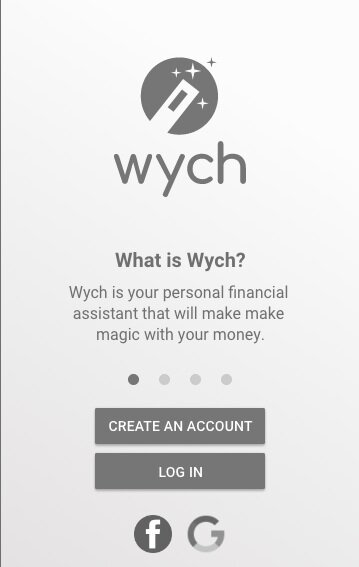Designing an onboarding experience for Wych App
“New users who came onto your platform are motivated to make the most out of your product, so make it simpler and easy for them to do so.”
About the project
Wych is a personal financial assistant that connects to user’s banks and other financial service providers, leveraging user spending trends and artificial intelligence to offer budgeting analysis, spending recommendations. The product is currently live in New Zealand with plans for the business to expand to Australia and the UK. Wych’s goal is to educate users on how to budget and give them financial power.
My team and I were brought in to conduct user research and design the onboarding process. There were two major challenges: to show the value of Wych at the very first interaction with the product and to build trust with users to share their financial information during the process. Designing an onboarding process is very dependant on the flow. The process should educate the user to what the product can do for them and it shouldn’t be too long and complicated that will make users abandon the app.
The steps to success
As the project was under a short timeline, we had to make sure we stay organised and focused. So for this project we relied on Agile sprints and the double diamond UX methodology to guide us and tackle the design process in 4 phases: Discover, Define, Develop and Deliver.
Exploration
Understanding the business
Wych is a young product, so in order to understand the value that we can provide at a first glance, we had to understand the minimum viable product and what are the features that the client currently has in the product. I ran a MoSCoW prioritisation workshop, and together with our client, we prioritised all the features in 4 categories. In the Must Have category we added all the features that we should focus on in order to show the users how the product can meet their needs.
Understanding the users
The first round of interviews was conducted with 11 participants that fit the target demographic and the goal was to understand:
What is the participant’s relationship with budgeting?
How do they deal with finances?
Do they budget? What tools do they use?
How willing are they to share personal details with a third party app? What is important to them when they choose a financial assistant?
Common concerns from our interviews
What the insights showed:
Participants are concerned about security and privacy.
There is a need for financial education and personal budgeting which is what Wych is trying to provide.
All participants prefer to manage their finances on their phone which validated our client’s decision for going mobile and Android first.
Some participants were skeptical to provide access to their personal financial information, but are willing to try out a new product based on recommendations and positive reputation showing that there is a way to build trust amongst them.
Our persona
We synthesised the qualitative data that we gathered from our initial interviews alongside with data from our exploratory research using Affinity Mapping and we created our persona as a representation of our users and target audience.
The focus from here was to show Alex how Wych can help him with his frustrations and to build enough trust so he can begin his journey with the product.
Ideation
Design Principles
To stay aligned towards the common goal I created design principles that my team and I could follow. I made sure our client had a saying in the way their brand will be represented through conducting Ethics of Design workshop. It was crucial to follow those principles when designing in order to convince users to provide their financial information to the app.
Make it secure
Design to reassure users that their financial information will be in good hands.
Design with transparency
Be open about your decisions. Show users that their data and financial information has been processed and kept in a secure and lawful manner.
Trust is key
Design things that will build a long lasting relationship with our customers.
Design to inform
Provide the most relevant information and aim to make the learning curve shorter.
Make it intuitive
Leverage existing design patterns in order to make the process feel natural and are easy to learn.
Initial concepts
After identifying the goals and frustrations of our users, we created concept cards that we showed to our target customers and users. Based on that feedback, we took some of the ideas forward to a mid fidelity prototype that we tested with 14 participants.
Goal driven approach
Goal: provide relevant information
Users will be shown features based on their personal goal so they can decide whether to move forward the onboarding process (linking bank accounts).
PIN and biometrics set up
Goal: security, trust, reassurance
Users can protect their account by setting up a PIN and fingerprint/Face ID depending on the capacity of their device.
Data/feature preview
Goal: transparency, trust, reassurance
Users can see how and where their data will be used for each individual feature before deciding to provide their bank accounts information to Wych.
Data Collection
Goal: trust
This concept allows users who are unwilling to immediately trust Wych with their personal financial information to take a survey in order to access some of Wych’s features. This will provide an alternative route but also reiterate the value of bank connection.
Mid-fidelity prototype and user testing
14 participants
Aged between 20-60
Based in the UK, Ireland,
New Zealand
Testing the concepts helped to determine the initial flow for the onboarding process. Each section tackled questions that were going through our users’ minds during the first two rounds of interviews. In the section below, I will discuss the features that we introduced and the results that we found based on the final round of testing.
Initial flow
The important questions
Did we build enough trust for users to connect their bank accounts to Wych?
Did we create a process that was simple and easy for users?
Value proposition - design comparison
The first two screens represent the goals approach in a form of value proposition. Users can click on the different goals and the circle will expand to show them which features will be relevant to that gaol. I designed additional 4 screens that would rotate in a form of a carousel and display Wych’s value proposition.
Research results
1. Most users did not understand that the circles were interactive and did not feel strongly towards this option.
2. 10 out of 14 participants preferred the carousel as a value proposition as it does not require any input from their side.
Data and features preview
Asking our users to connect their bank accounts is the most important part of the onboarding flow. With this feature I wanted to provide reassurance to our users and we placed the Data/Feature preview here. I used simple language (inspired by Monzo) to make it easy for users to understand legal terms. Users can then click on ‘Connect bank’ or ‘Skip’.
Research results
1. Users felt more inclined to connect their bank account after interacting with this feature.
2. They appreciated the transparency behind this feature which made them trust the app more.
3. Most participants linked their bank accounts.
To keep things concise I only included the areas that I personally worked on and tested.
Final flow and prototype
The insights that we gathered we realised the following: we managed to gain trust amongst our users but there was still room for improvement in terms of the simplicity and ease of use of the flow. With speed and ease in mind, we made a few instrumental changes in order to simplify the overall process.
Final onboarding journey from a user perspective
Full onboarding map can be found here.
Let’s answer our questions
Did we build enough trust for users to connect their bank accounts to Wych? Yes.
Did we create a process that was simple and easy for users? Yes.
Conclusion
First interactions count. A good onboarding experience can turn a new user to a loyal customer. A bad onboarding experience can frustrate the user to the point where they will abandon the app and never return.
Finding the right balance of information and flow for Wych’s unique customers was not an easy task. Most of our participants in our initial interviews did not feel comfortable sharing their financial information to a third party app. In the end, through the onboarding process users felt that their data is in good hands.
The Wych team decided to take the design forward and the next step will be development.
Take a look at our final prototype here.
And finally, thank you for stopping by. I hope you enjoyed reading this case study and if you wish to discuss it further, please feel free to reach out.
Prototype workthrough
Client testimonial
“Tashko took part in a review of the Wych registration flow. Tashko's communication and organisation skill impressed me. I found the detail of Tashko's work stood out and his contribution to the final state provided a quality result.”
- Dermot Butterfield, CEO and founder of Wych Limited























